Manuscript accepted on : 07-07-2021
Published online on: 27-07-2021
Plagiarism Check: Yes
Reviewed by: Dr. Abdelkader Hamlat
Second Review by: Dr. Hassan Hayder
Final Approval by: Dr. Imran Ali
Indoor Hydroponics: A Potential Solution to Reuse Domestic Rinse Water
Prashanthini Sundar1, Krishnamoorthy Jyothi1 and Chalini Sundar2*
1Cambridge IGCSE Section, New Middle East International School, Sulaimaniyah, Riyadh, Kingdom of Saudi Arabia. 12242.
2Department of Dental Public Health, Identiti Dental Centre, Chennai, Tamil Nadu, India. 600042.
Corresponding Author E-mail: Chalini.sundar@gmail.com
DOI : http://dx.doi.org/10.13005/bbra/2924
ABSTRACT: The objective of this study was to evaluate the potential of reusing domestic rinse water in an indoor hydroponic system and compare the growth pattern of Coleus plants using tap water and rinse water. A preliminary survey evaluatedthe knowledge about, home gardening, hydroponics, water usage and utility of rinse water in urban households. The experimental setup consisted of water culture hydroponic system with peat moss media. Data were collected and analyzed from 4 sample groups: Group A (tap water), B (tap water with NPK fertilizer), C (rinse water) and D (rinse water with NPK fertilizer) in a randomized experimental design (N=20) with five replicates.The study was conducted indoors in an urban household under controlled temperature (78ºF), light and humidity (60-70%). Parameters analyzed for assessment of plants growth included height (in millimeters), number of new leaves and leaf surface area. Environmental parameters including, pH and TDS (Total Dissolved Solids in parts per million) of the hydroponic solution, and pH and moisture of soil were also recorded. Descriptive statistical analysis and independent comparisons were done with a 95% assumed significance level (p<0.05).During the 20th, 25th and 30th day, plant height in Group A was significantly (p<0.05) higher than that of Group B and plant height in Group C was significantly higher than in Groups B and D.In terms of the environmental parameters, while rinse water had an alkaline pH, the addition of NPK fertilizer (Groups B and D) resulted in significantly lower pH.Based on the present study results, domestic rinse water can be reused as a successful alternative for tap water in indoor hydroponic cultivation of plants without the need for any additional fertilizer.
KEYWORDS: Coleus Plants; Hydroponic Cultivation; Indoor Hydroponics; Rinse Water Recycling; Waste Water Management
Download this article as:| Copy the following to cite this article: Sundar P, Jyothi K, Sundar C. Indoor Hydroponics: A Potential Solution to Reuse Domestic Rinse Water. Biosci Biotech Res Asia 2021;18(2). |
| Copy the following to cite this URL: Sundar P, Jyothi K, Sundar C. Indoor Hydroponics: A Potential Solution to Reuse Domestic Rinse Water. Biosci Biotech Res Asia 2021;18(2). Available from: https://bit.ly/3i3SwLK |
Introduction
We are entering an era where abundant, clean water is no longer guaranteed. The mounting demand on this finite and invaluable resource has inspired creative methods for water management, including scientific techniques for wastewater recycling. On the other hand, shortage of potable water and increasing urbanization have strained the ecosystem especially in terms of the amount of water and space available for farming and gardening.1 Knowledge about rinse water use in home gardening has been increasing since it represents an alternative source of water and nutrients for plant crops.2, 3Rinse water recycled and reused in hydroponics helps in waste water management.However, the innovative idea of hydroponics using rinse water for indoor gardening has not been practiced and could be evaluated only through research.
Hydroponic systems irrespective of their scale, are an innovative method of cultivation which reduces dependence on soil as a substrate, and instead derives nutrition directly from the hydroponic solution comprising of water and nutrients.4 While conventional hydroponic systems used fresh water supplemented with nutrients, the last decade has seen increasing interest towards using waste water as a source of hydroponic nutrition. This aims at a dual benefit of optimizing water reuse as well as a practical end point for waste water management.3, 5 This is evident from the several reports published in the literature pertaining to waste water based hydroponic cultivation.1-3, 5-8 Based on an extensive review, Prazeres et al.5 characterized different sources of waste water that could potentially be used in hydroponic systems. These included waste water from domestic sources as well as from dairy, food processing, brewery and textile industries.
Domestic waste water can be classified as grey water and black water, with the former derived from routine household cleaning and laundering and the latter representing waste water from sanitation.1, 2, 9 Although domestic waste water has been proven to be a source of agriculturally useful nutrients such as nitrogen, phosphorous and potassium (NPK), biological contamination with organic matter remains one of the major challenges with its use in hydroponics.5, 10 In an effort to overcome this challenge we envisaged an indoor hydroponic system utilizing domestic rinse water which has been proven to have minimal biological contamination owing to the detergents and high temperatures used during laundry cycles. Furthermore, domestic rinse water represents an easy modality of water use and could effectively save up to 1000-1500 liters of water per week in an average household.2 This amount of saved water can cumulatively benefit the urban population in developing countries wherein water shortage is always an impending challenge.1-3
In addition, Zimmermann and Fischer11 have reported the promising economic viability of hydroponic systems especially when used for small scale food crop production, such as tomatoes, lettuce, greens etc. In light of the above evidence, our research proposes a novel model for indoor hydroponic cultivation by reusing a portion of domestic waste water which could be replicated in urban households the world over. If the above novel idea can be proved by research, several vegetables and economically important flowers can be grown indoor using rinse water. Accordingly, a hydroponic irrigation system with rinse water was designed for an indoor garden. This study was based on the hypothesis that, growth pattern of plants in an indoor hydroponic garden does not differ with domestic rinse water (with or without nutrients) when compared to tap water under controlled environmental conditions along the growth cycle.
Methodology
Community Survey
As a preliminary step towards the experiment, a validated survey questionnaire (Annexure 1) was designed to evaluate knowledge about, home gardening, indoor hydroponics, water usage and utility of rinse water in urban households. The survey was distributed to 100 urban households as a digital survey through Google Forms. Responses were collected and represented graphically.
Experimental Study
The experimental sample consisted of 20 variegated Coleus (Plectranthus) plants (N=20), which were randomized and distributed equally to four sample groups (n = 5 samples per group). The experimental setup was replicated in each group and was composed of a water culture hydroponic system, containing a trough (38cm x 26cm) and an aeration pump to replenish water oxygen and prevent algal bloom (Figure 1). With 5 plants per hydroponic trough, the spacing was 5cm between plants on all sides and each trough was filled with 7.5L liquid (Figure 2). According to the study group, the troughs were filled with either tap water (Group A), tap water mixed with NPK fertilizer (GranSol 15-15-15 TE Nitrogen Phosphorus Potassium fertilizer, Sunset Limited, Cairo, Egypt) at a concentration of 10 grams per liter (Group B), rinse water (Group C) or rinse water with NPK fertilizer (10 grams per liter) (Group D) (Figure 2). Untreated second-rinse water was obtained from the drain pipe of a household washing machine, and it was selected to avoid the side-effects of surfactants and bleaching agents on plant growth. Replenishment of liquid in the respective troughswas carried out once in 10 days. The study was conducted indoor in a domestic urban household under controlled temperature (78ºF), light and humidity (60-70%).
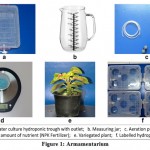 |
Figure 1: Armamentarium. |
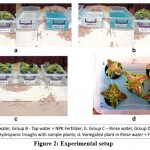 |
Figure 2: Experimental setup |
The parameters analyzed for assessment of plants growth pattern included height of the plant (in millimeters), the number of new leaves and the surface area of the leaves. Environmental parameters included, pH and TDS (Total Dissolved Solids in parts per million) of the hydroponic solution, and pH and moisture of soil (Figure 3).At the beginning of the experiment, the baseline height and leaf count were recorded for all the plants included in the study (N = 20), and the surface area of one leaf per plant was obtained. Thereafter, only the height of the plants were periodically measured on the 5th, 10th, 15th, 20th, 25th and 30th days. Additionally, on the 30th day, after excluding the number of leaves shed, total number of leaves and surface area of the previously measured leaf were obtained once again for each plant sample.Environmental parameters, namely quantity of tap water/rinse water added in each group, water quality (pH and TDS), soil quality (pH and moisture) and ambient light were measured at the beginning of experiment and periodically on the 10th, 20th and 30th days. Inter-examiner and intra-examiner reliability of the measured parameters were tested initially in a pilot sample of the plants.
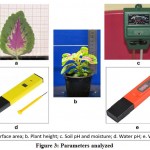 |
Figure 3: Parameters analyzed. |
Statistical Analysis
All quantitative data were recorded and tabulated in a spreadsheet software (MS Excel 2016, Microsoft Corporation, Redmond, WA, USA). Descriptive statistical analysis and independent comparisons were done using statistical software (IBM SPSS Statistics Ver. 20, IBM Corporation, Armonk, NY, USA). Significance was assumed when p-value was less than 0.05 (p<0.05).
Results
In terms of the survey conducted in domestic households, a total of 86 participants responded to the survey. Majority of the households had 3-4 members (60.5%) and almost all of them (95.3%) liked home gardening. Tap water was mainly used for watering plants (73.3%) and several people knew about hydroponics (60.5%). However, very few people used waste water for plants (11.6% – 29.1%) (Figure 4).
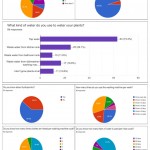 |
Figure 4: Survey response. |
All plants remained healthy throughout the experiment. The average height of the plants in every group was similar during the 5th day and 10th day. Significant differences in plant height were observed during the 20th, 25th and 30th day observations. During these time periods, plant height in Group A was significantly higher than that of Group B and plant height in Group C was significantly higher than in Groups B and D. (Figure 5) Significant increase in the number of leaves was observed in Group C, in comparison to Groups B and D. While there was no significant difference between Group A and Group C, increase in number of leaves in Group A was only greater than Group B and not with respect to Group D. However, in terms of the leaf surface area the increase in Groups A and C were significantly higher than that of Groups B and D. Moreover, the increase in leaf surface area in Group D was significantly higher than that of Group B (Figure 6).
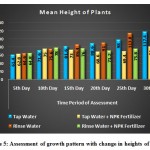 |
Figure 5: Assessment of growth pattern with change in heights of plants. |
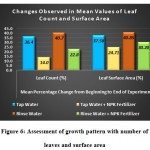 |
Figure 6: Assessment of growth pattern with number of leaves and surface area. |
In terms of the environmental parameters measured, no significant differences were observed between the groups for all variables except water quality (pH and TDS). Addition of NPK fertilizer (Groups B & D) resulted in significantly lower pH and increased TDS value. Between tap water (Group A) and rinse water (Group C) a significantly alkaline pH with higher TDS was observed in Group C. Nevertheless, the soil pH although different between the groups was not statistically significant. Descriptive data pertaining to all the measured variables are shown in Tables 1 and 2.
Table 1: Assessment of Plant growth pattern
| Test Groups | Mean Plant Height During Different Time Periods of Assessment(in millimeters) | Mean Change from Beginning to End of Experiment (%) | ||||||
| Day 5 | Day 10 | Day 15 | Day 20 | Day 25 | Day 30 | Leaf
Count |
Leaf
Surface Area |
|
| Tap Water | 61.4 | 71.6 | 81.6 | 88.6 | 98 | 117.4 | 36.4 | 36.5 |
| Tap Water + NPK Fertilizer | 62.8 | 75 | 73 | 68.6 | 69.4 | 81 | 14.0 | 26.5 |
| Rinse water | 64.6 | 75.6 | 86.4 | 91 | 113.8 | 130.6 | 40.7 | 43.1 |
| Rinse water + NPK Fertilizer | 64.8 | 78 | 76 | 71.2 | 75.8 | 87.8 | 22.8 | 32.0 |
Table 2: Changes in Environmental parameters.
| Test Groups | Time
Period |
Hydroponic Environment | External Environment | ||||||
| Water Quantity | NPK Fertilizer | Water Quality | Soil Quality (Mean) | Ambient
Light |
|||||
| Initial | Additional | pH | TDS | pH | Moisture | ||||
| Tap Water | Start | 7.5 L | – | – | 7.1 | 382 | 8.00 | 8 | 900 – 1000 |
| Day 10 | – | 870 mL | – | 7.2 | 387 | 7.75 | 8.5 | ||
| Day 20 | – | 880 mL | – | 7.1 | 386 | 7.50 | 8.5 | ||
| Day 30 | – | 885 mL | – | 7.3 | 391 | 7.50 | 9 | ||
| Tap Water +
Fertilizer |
Start | 7.5 L | – | 75 g | 6.2 | 402 | 8.00 | 8.5 | 900 – 1000 |
| Day 10 | – | 890 mL | – | 6.3 | 404 | 7.00 | 9 | ||
| Day 20 | – | 875 mL | – | 6.4 | 407 | 6.75 | 9 | ||
| Day 30 | – | 880 mL | – | 6.6 | 407 | 6.50 | 9.5 | ||
| Rinse water | Start | 7.5 L | – | – | 8.3 | 451 | 8.00 | 8 | 900 – 1000 |
| Day 10 | – | 865 mL | – | 8.4 | 453 | 8.25 | 8.5 | ||
| Day 20 | – | 880 mL | – | 8.4 | 457 | 8.25 | 8.5 | ||
| Day 30 | – | 890 mL | – | 8.5 | 460 | 8.50 | 9.5 | ||
| Rinse water +
Fertilizer |
Start | 7.5 L | – | 75 g | 6.4 | 468 | 8.00 | 8 | 900 – 1000 |
| Day 10 | – | 870 mL | – | 6.6 | 470 | 7.25 | 8.5 | ||
| Day 20 | – | 865 mL | – | 6.9 | 471 | 6.75 | 9 | ||
| Day 30 | – | 875 mL | – | 6.9 | 470 | 6.75 | 9 | ||
Discussion
This study conceptualized an approach to turn household rinse water into a useful resource, optimize space utilization and use water sparingly. Knowledge about the growth of plants at each stage of development, when cultivated using rinse water hydroponics, can provide valuable guidance about growing food crops through home gardening and help achieve self-sustainability. Ecologically, vertical gardening with hydroponics can minimize land usage and prevent deforestation, soil erosion and eutrophication, thereby safeguarding the ecosystem.12Nearly six different hydroponic techniques have been reported in the literature including nutrient film, raft, ebb and flow, aeroponic, wick and water culture, and combinations of the above techniques.4 In the present study, a water culture hydroponic system was used considering the indoor environment in which the research was done. Moreover, the results of this study indicate the replicability of indoor water culture hydroponic systems with minimal set-up and ease of maintenance. These findings are in coherence with the data reported by Abdelmawgoud et al.4who reported greater economic viability for production of tomato crop using indoor hydroponics in green houses. They further reiterated that hydroponic cultivation is sustainable and profitable on the long run in spite of the high initial costs, which has always been an inhibitory factor towards embracing hydroponics.
Based on the above observations, it is seen that plant growth is significantly better in an indoor hydroponic garden with rinse water and tap water, in the absence of any fertilizers. The interesting outcome of the present study is the fact that plain rinse water resulted in better plant growth than tap water or water (tap/rinse) with fertilizers. Similar results were reported in a study conducted by Nyomora (2015) based on irrigating paddy fields with waste water.1 Based on a randomized paddy crop irrigation model with either waste water or tap water, and either with or without additional NPK fertilizer, they reported a four-fold increase in yield per hectare when crops were irrigated with waste water only.1 Furthermore, they reported a drop in crop yield when NPK fertilizer was added to waste water, a finding which was observed in the form of reduced plant growth in the present study too (Fig. 5 and Fig. 6; Table 1). It has further been reported that closed hydroponic systems, similar to what was used in the present study, facilitate nutrient reuse in addition to optimizing water usage.13 Based on an electrical conductivity study, Christie13 observed retention of essential NPK nutrients which promoted growth of lettuce crop in a closed hydroponic system. Although no similar electrolytic assessment was conducted in our study, this could form the basis for future evaluation of nutrient availability in domestic rinse water.
Domestic wastewater represents a major source of runoff waste water which could potentially be used for alternative purposes other than drinking, cooking or sanitation.5 It is further classified as black wateror grey water. While black water is never considered for reuse, grey water can be reliably reused either with or without treatment, and also contains minerals and trace elements (NPK), which could potentially benefit agriculture and crop growth.5, 10In addition to the risk of microbial contamination, the presence of heavy elements such as arsenic, cadmium, chromium, lead, mercury and nickel, is also a cause for concern while reusing grey water.6, 14 The risk of microbial contamination was eliminated in the present study by using the 2nd rinse cycle water from washing machines, as harmful bacteria and microbes are usually removed during initial washing cycle with soap/detergent/disinfectant.5 Although presence of heavy metals was not evaluated in this study, cultivation of lettuce using grey water containing differing concentrations of heavy metal elements in a green wall hydroponic garden did not result in heavy metal pollution risk within plant leaves.6 It was further reported that grey water with trace microbial contamination did not pose a health risk in any of the 3 species of lettuce which were cultivated using hydroponics.6
Based on our survey, an average household of 2 adults and 2 children, using the washing machine once every 2 days, could contribute to approximately 50 – 60 liters of rinse water per wash cycle. Extrapolating it annually, that would be approximately 9000-10000 liters of potentially reusable water going down the drain wastefully, per family. This becomes an even bigger number if the rinse water from dish washers and laundry dryers are further taken into account. In effect, a housing society comprising 100 families would be wasting 1.5 – 2 million liters of potentially reusable water. Although our research proved the growth of non-edible plants in a small scale indoor hydroponic garden, these results could be easily applied on to edible, decorative and floral plants in an indoor setting, as has been reported in literature.5, 6, 8, 9, 12 Unfortunately, most of the above studies reporting the successful use of hydroponics, fail to report their viability in a small scale domestic setting, a research gap which our study aimed to fulfill.
One unique aspect of the present study was the comparison of environmental parameters between the groups with respect to hydroponic solution and substrate soil, under an indoor hydroponic setting. The amount of hydroponic solution used and soil moisture were almost similar in all the groups across different time periods, similar to that reported in earlier studies utilizing varying hydroponic setups.2, 3, 5, 13It was observed that rinse water had greater alkalinity and TDS in comparison to tap water. This could have contributed to significantly better plant growth with rinse water alone in our indoor hydroponic setting. Based on a review,Prazeres et al.5reported similar findings, wherein domestic waste water with neutral to alkaline pH and higher suspended solids, was the optimal choice for agricultural reuse in hydroponic systems. The addition of NPK fertilizer to both tap water and rinse water resulted in acidification of the hydroponic solution, as observed in the present study, leading to poor plant growth. However,the above findings are in contrast with those of Carvalho et al.7who reported depleted mass and nutrient deficiency in lettuce crop grown in a hydroponic system using wastewater alone. This could possibly be explained by the role of treated wastewater used in the above mentioned study7, in contrast to untreated second-cycle rinse water used in our study. Nevertheless, it was observed that the soil pH in our samples did not vary significantly between the groups irrespective of the addition of fertilizer, thereby implying a plausible role for soil based hydroponics in wastewater treatment. In this regard, several studies in the literature have proposed wastewater hydroponics as a modality to treat and dispose wastewater in varying scales.2, 3, 8, 14
With the ever dwindling water resources and never-ending urban space shortage, indoor hydroponic gardens are the way forward to a healthy and sustainable future. They can help grow anything from decorative vertical gardens, to a fresh organic vegetable farm right at the corner of our living rooms.Home grown, fresh and pesticide free vegetables and fruits can be a rich source of nourishment for our future generation.4 The innovative approach of hydroponic gardening with rinse water, is a multi-pronged strategy which helps reduce wastage of precious fresh water, reuses rinse water which is otherwise washed down the drains, conserves space, cleanses indoor atmosphere and does not harm the environment.Moreover, it could be a possible method of treating domestic wastewater even within limited urban spaces through vertical hydroponics, along with the benefits of landscape irrigation, minimizing land usage, preventing deforestation, soil erosion and eutrophication.2, 3
In spite of the novel nature of the present study reporting about indoor hydroponics with rinse water for the first time, to the best of knowledge from published literature, the use of a single plant species as test samples is a limitation. While long term studies with differing plant species and fertilizer concentrations may yield additional information, the available results imply an eco-friendly, economic, efficient and sustainable method of indoor gardening. Further research is therefore needed to identify suitable concentration and type of nutrient fertilizers, which promotes plant growth for indoor hydroponic gardens.
Conclusion
Based on the results of the present study, untreated domestic rinse water obtained from washing machine second-cycle rinse can effectively be used for indoor hydroponic cultivation of plants without the need for any additional fertilizer.The current results validate the potential of domestic rinse water as an alternative to precious fresh water for indoor hydroponic cultivation. Furthermore, indoor hydroponics with rinse water is an obvious potential end-use for recycling domestic waste water and can conserve a high percentage (40%) of fresh tap water. It also entails the benefits of significant savings in water use, sewage disposal, ecosystem protection and the possibility to produce economically viable food crop.
Acknowledgement
The authors would like to acknowledge New Middle East International School, Riyadh and Science India Forum, Saudi Arabia Chapter for facilitating conduct of this research work.
Conflict of Interest
There is no conflict of interest to be declared.
Funding Source
There is no funding or financial support for this research work.
References
- Nyomora A. M. Effect of treated domestic wastewater as source of irrigation water and nutrients on rice performance in Morogoro, Tanzania. J Env Waste Manag 2015; 2(2): 47-55.
- Pinto U., Maheshwari B. L. Sustainable graywater reuse for residential landscape irrigation – a critical review. Chin J Pop Res Env 2015; 13(3): 250-64.
CrossRef - Tzanakakis V., Koo-Oshima S., Haddad M., et al. The history of land application and hydroponic systems for wastewater treatment and reuse. In: Rose ANAJB, ed. Evolution of Sanitation and Wastewater Technologies through the Centuries; IWA Publishing: London, UK; 2014: 457.
- Abdelmawgoud S. M. S., Aziz H. H. A., Shibl A. A. A., Qabeel M. A.-S. A Comparative Economic Study of Tomato Production by Hydroponics and Conventional Agriculture (With Soil) in Greenhouses: A Case Study in the Nubaria Region. Asian Journal of Agricultural Extension, Economics & Sociology 2021: 126-40.
CrossRef - Prazeres A. R., Albuquerque A., Luz S., Jerónimo E., Carvalho F. Hydroponic System: A Promising Biotechnology for Food Production and Wastewater Treatment. Food Biosynthesis: Elsevier; 2017: 317-50.
CrossRef - Eregno F. E., Moges M. E., Heistad A. Treated Greywater Reuse for Hydroponic Lettuce Production in a Green Wall System: Quantitative Health Risk Assessment. Water 2017; 9(7): 454.
CrossRef - Carvalho R. D. C., Bastos R. G., Souza C. F. Influence of the use of wastewater on nutrient absorption and production of lettuce grown in a hydroponic system. Agri Water Manag 2018; 203: 311-21.
CrossRef - Magwaza S. T., Magwaza L. S., Odindo A. O., Mditshwa A. Hydroponic technology as decentralised system for domestic wastewater treatment and vegetable production in urban agriculture: A review. Sci Total Environ 2020; 698: 134154.
CrossRef - Finley S., Barrington S., Lyew D. Reuse of Domestic Greywater for the Irrigation of Food Crops. Water Air Soil Poll 2009; 199(1-4): 235-45.
CrossRef - Boyjoo Y., Pareek V. K., Ang M. A review of greywater characteristics and treatment processes. Water Sci Technol 2013; 67(7): 1403-24.
CrossRef - Zimmermann M., Fischer M. Impact assessment of water and nutrient reuse in hydroponic systems using Bayesian Belief Networks. Journal of Water Reuse and Desalination 2020; 10(4): 431-42.
CrossRef - Gashgari R., Alharbi K., Mughrbil K., Jan A., Glolam A. Comparison between growing plants in hydroponic system and soil based system. Proceedings of the 4th World Congress on Mechanical, Chemical, and Material Engineering; 2018: ICMIE Madrid, Spain; 2018. p. 1-7.
CrossRef - Christie E. Water and Nutrient Reuse within Closed Hydroponic Systems: Georgia Southern University; 2014.
- Bliedung A., Dockhorn T., Germer J., Mayerl C., Mohr M. Experiences of running a hydroponic system in a pilot scale for resource-efficient water reuse. Journal of Water Reuse and Desalination 2020; 10(4): 347-62.
CrossRef

This work is licensed under a Creative Commons Attribution 4.0 International License.





